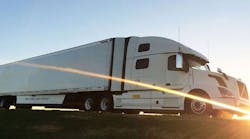Why We’re Reshoring Our Manufacturing: A CEO’s View
In 2015, I started my high-tech trucking panel company in a garage. I was still in graduate school, getting my MBA from Stanford University, and money was tight.
We began making prototypes of our concept: panels that would automatically deploy at highway speeds to seal the gap between the tractor and trailer to help improve truck aerodynamics and save fuel. As demand for TruckWings increased, we struggled, and our suppliers struggled to hire good manufacturing technicians because the U.S. unemployment rate was so low.
Eventually, we started sourcing parts from all over the world—Taiwan, Mexico, China. Labor was cheaper in those places compared to the United States, and you must control costs in this industry. We kept some business-critical operations, such as advanced research, software, firmware and cybersecurity in Silicon Valley. But having a global supply chain made a lot of sense.
The global supply chain model is now under scrutiny because of the epic disruptions caused by the COVID-19 pandemic. Strategies such as lean manufacturing, offshoring and outsourcing also are being reassessed. Will China continue in its dominant role as the “world’s factory”? Will U.S. companies reshore previously offshored manufacturing?
The idea of reshoring is picking up momentum in light of the pandemic as a way to simplify supply chains and make companies less vulnerable to future disruptions. I’m not going to predict the future, but I’m going to talk about why my company, XStream Trucking, decided to reshore some of its manufacturing and the impact those decisions have had, which could serve as an example to others.
We started taking a close look at our supply chain long before the pandemic hit. The first big inflection point came in 2018, when a trade war broke out between the U.S. and China. The imposition of U.S. tariffs on some of our parts came as a surprise. As a start-up still building our business and reputation, we couldn’t afford to pass along additional costs to our customers.
China’s advantages—a large workforce, low labor costs, efficient logistics, stable infrastructure—had already been shrinking prior to the trade war. The tariffs were just the incentive for us to rethink our supply chain. We couldn’t predict how long the trade war would last, and that uncertainty was too big a risk for our supply chain.
There are other low-cost countries in Asia like Bangladesh and Vietnam. But the decision on where to source parts and assemble the panels was more than a matter of comparing labor costs. We compared materials cost, shipping, operational complexities, and the risk of business disruptions. Our product requires custom parts from multiple specialty manufacturers. The panels, for example, require specialized tubing and aluminium-formed mounts that have to be laser-cut and formed.
Another important factor was the evolution of our business. Right now, a lot of our customers are North America, so manufacturing closer to them could save time and money. International freight naturally creates extra steps in the process, including unpacking and inspecting for damage during shipping. If parts are damaged, then we have to powder coat for that shipping damage, repack, and ship again. With a regional supply chain, we also can eliminate those unexpected delays due to custom’s clearance at ports.
In all, we’ve brought back about 60% of our production requirements to the U.S. In addition to two providers in Ohio, XStream Trucking works with suppliers in Pennsylvania and Arizona. We also assemble many of the units at a site in North Carolina. Our U.S. suppliers also are a little bit ahead of their foreign competition when it comes to automation. The key is a mixture of advanced machinery and people, in both high- and lower-skill jobs.
Reshoring has brought significant benefits to the company. For instance, for our aluminium mount system, we trimmed costs by about 20% and cut our lead time from 8 weeks to 4 weeks. For our panelling system, we had about a 10% reduction in costs and a reduction in lead time from 8 weeks to 5 weeks.
The simplification of our supply chain and logistics cannot be overestimated, especially in our current COVID-19 environment. The pandemic demands fast and strategic decisions in the face of uncertainty. We can still serve our customers if a plant in Mexico is shut down because we have a supplier in Ohio up and running.
In a matter of five short years, we moved a lot of manufacturing offshore and now brought back a lot of it. It’s been painful, I’m not going to lie. But I’m glad we are back home.
Daniel Burrows is CEO and founder of XStream Trucking.




